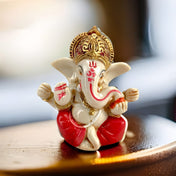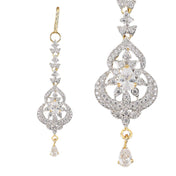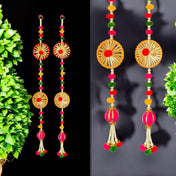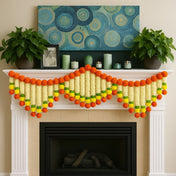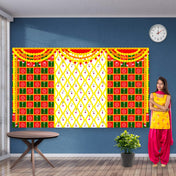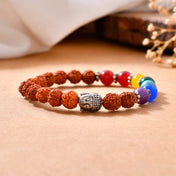DIY Indian Decorative Items for Home offers a unique way to bring vibrant culture and timeless tradition into your living spaces. This guide will teach you how to create beautiful Indian decor that goes beyond just looking nice, but also tells stories and represents heritage.
In this guide, you'll find practical techniques and creative ideas for making your own DIY Indian decorative items. We'll cover everything from intricate miniature figurines to colorful rangoli designs. Our focus is not only on decoration but also on honoring centuries-old traditions while making them suitable for modern homes.
Incorporating traditional Indian crafts into home decor brings life to rooms, turning them into cozy and meaningful places. These handmade elements connect us to cultural narratives, making our everyday surroundings more than just visually appealing. By engaging with these crafts, we cultivate mindfulness and appreciation for the skilled artisans behind each piece.
Why choose DIY Indian decor?
- Personalization that reflects your unique taste and cultural curiosity
- Sustainable creativity using authentic materials like terracotta, brass, and fabric
- A meaningful link between past artistry and present-day expression
Join us on this journey as we celebrate Indian craftsmanship by creating decorative treasures that speak to both the eyes and soul of your home.
Understanding the Essence of Indian Decorative Items
Indian heritage shines brilliantly through traditional crafts that have been nurtured and perfected over centuries. Each handmade decor piece reflects a story, a ritual, or a belief deeply embedded in the cultural fabric of India. These indian decorative items are not just objects; they are carriers of history and symbols of artistry passed down through generations.
Materials used in crafting Indian decorative items
Materials commonly used in crafting Indian decorative items include:
- Terracotta: Earthy and rustic, terracotta offers warmth and texture to home decor. Its natural clay origin makes it perfect for pots, sculptures, and lamps.
- Wood: Intricately carved wooden pieces bring an organic charm and timeless elegance to interiors.
- Ceramic: Painted or glazed ceramics add vibrant colors and smooth finishes, often seen in decorative plates and tiles.
- Brass: Known for durability and shine, brass is favored for statues, diyas (oil lamps), and ornamental accents.
- Fabric: Textile crafts like Pichwai paintings or embroidered wall hangings use fabrics as canvases for ethnic designs.
Symbolism in Indian decorative arts
Symbolism plays a crucial role in Indian decorative arts. Popular cultural motifs carry deep meanings:
- Elephants symbolize wisdom, strength, and good fortune. Miniature elephant figurines or motifs bring auspicious vibes to any space.
- Floral patterns represent beauty, fertility, and the cycle of life. These patterns often appear in wood carvings, fabrics, and rangoli designs.
- Rangoli designs are intricate floor decorations made during festivals to invite prosperity and happiness into homes.
These elements together create a rich tapestry of meaning that transforms simple decor into soulful expressions of Indian tradition.
Popular Types of DIY Indian Decorative Items for Home Decor
1. Miniature Figurines and Pichwai Art: Bringing Indian Culture to Life
Miniature figurines hold a cherished place in Indian home decor, often crafted to represent elements of nature, mythology, or cultural symbols. Elephants, among the most popular motifs, symbolize strength, wisdom, and good fortune in Indian tradition. Creating your own miniature figurines can be a rewarding project that connects you with centuries-old craftsmanship.
Cultural Symbolism of Miniature Figurines
- Elephants: Emblematic of Lord Ganesha, these figures are believed to remove obstacles and invite prosperity.
- Peacocks: Representing beauty and grace, they often appear in royal-themed decor.
- Deities and Folk Characters: Reflect spiritual stories and regional folklore.
Hand-painting or molding these figurines from clay or air-dry materials allows you to add personal touches while honoring their traditional significance.
Step-by-Step Guide: Pichwai-Inspired Wall Hangings Using Fabric Paints
Pichwai art originates from Rajasthan and portrays scenes from Lord Krishna’s life with intricate floral patterns and vibrant colors. Its exquisite detailing makes it an ideal DIY project that brightens any living space.
Materials Needed:
- Plain cotton or silk fabric (preferably white or pastel shades)
- Fabric paints in bright hues (blue, green, red, yellow)
- Fine paintbrushes
- Pencil for sketching
- Embroidery hoop (optional)
Instructions:
- Prepare the Fabric: Stretch the fabric on an embroidery hoop or flat surface to prevent wrinkles.
- Sketch the Design: Lightly outline a central motif like Krishna playing the flute surrounded by floral patterns using a pencil.
- Apply Base Colors: Fill larger areas first with vibrant fabric paint—use blues for Krishna’s attire and greens for foliage.
- Detailing: Add intricate dots, lines, and decorative borders to mimic traditional Pichwai style.
- Drying: Allow the paint to dry completely; setting with heat (iron on low) ensures durability.
- Display Ideas: Hang as a wall tapestry or frame under glass for a polished look.
Creating this piece invites a connection to Indian festive traditions while allowing creativity to flourish. The bold colors and symbolic themes make Pichwai-inspired decor a captivating complement to both ethnic and modern interiors.
Crafting miniature figurines or exploring Pichwai art transforms your home into a gallery of meaningful Indian heritage. These DIY projects not only blend artistry with cultural stories but also enrich everyday living spaces beautifully. For those looking to further explore Indian decorative items that can enhance their home decor, there are numerous resources available online that offer a wide range of options to choose from.
2. Terracotta Sculptures and Floral Garlands: Rustic Charm and Vibrant Decor
Terracotta sculptures bring an earthy warmth that evokes the heart of Indian tradition. Creating terracotta pots at home for festive occasions is a rewarding project that adds authenticity to your decor. Begin with plain terracotta pots, available at most craft stores, and prepare them by cleaning off any dust or residue. Use acrylic paints in vibrant colors like deep reds, bright oranges, and regal golds—these hues resonate with festival energy.
Decorative painting tips:
- Sketch traditional motifs such as paisleys, mandalas, or peacocks with a fine brush.
- Add intricate dots and lines using contrasting colors to enhance detail.
- Seal your artwork with a matte varnish to protect it from moisture and wear.
These painted pots can be used as planters for fresh flowers or as holders for diyas (oil lamps), instantly transforming any space with rustic charm.
Floral garlands have been an integral part of Indian home decor, especially during poojas and celebrations. They symbolize purity, beauty, and auspiciousness. Crafting these garlands yourself allows personalization while honoring cultural heritage.
Steps to design floral garlands:
- Choose fresh flowers like marigolds, jasmine, or roses for fragrance and vivid color. Artificial flowers provide durability and reusability.
- Thread flowers onto a strong cotton string or nylon thread using a needle or by hand.
- Combine different flower types or colors for patterns that suit doorways, windows, or pooja altars.
- Embellish with beads or small bells to add texture and sound.
Floral garlands not only brighten spaces but also invite positive energy into the home environment.
This section complements miniature figurines and Pichwai art by enriching your collection of DIY Indian decorative items for home with tactile textures and natural elements. Terracotta sculptures connect you to the earth’s raw beauty; floral garlands infuse vibrancy and fragrance—both vital in crafting an inviting Indian-inspired living space.
3. Rangoli Designs: Colorful Floor Art for Every Occasion
Rangoli designs are one of the most vibrant and cherished forms of DIY Indian Decorative Items for Home. These intricate patterns, traditionally created at the entrance of homes, invite positivity and auspiciousness. Crafting rangoli mats with powder colors or reusable stencils offers an accessible way to embrace this art form while adding a splash of color to any space.
Materials Needed
- Colored rangoli powders (available in bright hues like red, yellow, green, blue)
- Reusable plastic or metal stencils with traditional motifs such as lotus flowers, peacocks, or geometric shapes
- Chalk or white pencil for outlining
- Flat tray or mat base (optional)
Step-by-Step Guide to Making a Rangoli Mat
- Select Your Design: Choose from classic floral patterns or modern geometric shapes using stencils.
- Prepare the Base: Lay down a clean flat surface such as a tray or mat to contain the powder.
- Outline the Pattern: Lightly sketch the design using chalk or pencil for guidance.
- Fill with Colors: Carefully pour the colored powders within stencil boundaries or freehand outlines.
- Add Details: Use smaller quantities of contrasting colors to highlight motifs and enhance depth.
Creating rangoli mats blends creativity with tradition, echoing the charm found in miniature figurines, Pichwai art, terracotta sculptures, and floral garlands. Their temporary beauty invites continual renewal each day or festival, enriching living spaces with cultural heritage and joyful expression.
Incorporating DIY Indian Decor into Modern Home Settings
Bringing contemporary ethnic decor into living spaces offers a unique opportunity to celebrate cultural heritage while embracing modern design aesthetics. The charm of DIY Indian decorative items lies in their ability to blend tradition and modernity, creating an environment that is both vibrant and harmonious.
Strategies for blending traditional Indian decorative items with contemporary interiors:
- Focal Points with Statement Pieces: Use a handcrafted terracotta sculpture or a detailed miniature figurine as the centerpiece on a sleek console table or minimalist shelf. Their intricate craftsmanship contrasts beautifully with clean lines found in modern furniture.
- Subtle Accents Across Rooms: Smaller elements like brass candle holders or floral garlands can add warmth and texture without overwhelming a space. Placing these accents on side tables, window sills, or bedroom vanities introduces ethnic charm in understated ways.
- Mixing Textures and Materials: Pair fabric-based Pichwai wall hangings or embroidered cushions with neutral-toned upholstery to create depth through color and material contrast. Combining natural fibers with polished surfaces enriches the tactile experience within a room.
- Color Coordination: Select DIY decor pieces that complement existing palettes. For instance, vibrant rangoli-inspired mats placed near entryways can brighten neutral floors, while warm brass tones harmonize well with both cool and warm interior schemes.
- Functional Ethnic Decor: Incorporate handmade trays, bowls, or lanterns that serve practical purposes alongside their decorative appeal. This approach ensures that cultural elements remain woven into daily life rather than isolated display items.
Living rooms benefit from bold ethnic statements that invite conversation and showcase heritage. Bedrooms become serene retreats when adorned with soft fabric art or subtle motifs inspired by Indian traditions. Integrating these DIY Indian Decorative Items for Home creates spaces where personal stories meet artistic expression—honoring both past and present sensibilities without compromise.
Celebrating Festivals with DIY Indian Decorative Items
Festivals in India come alive through vibrant Diwali decorations and festival-inspired decor that transform homes into sanctuaries of joy and tradition. Crafting your own festive adornments not only personalizes the celebration but also deepens the connection to cultural roots.
Festival-Specific Decorations
1. Diwali Lanterns (Kandils)
These radiant paper lanterns symbolize hope and light overcoming darkness. Creating DIY kandils involves folding colored papers into geometric shapes, embellishing with glitter, beads, or cut-out patterns. Hanging them near windows or doorways invites warmth and auspiciousness.
2. Golden Pots (Kalash)
Often used in pooja rituals, golden pots represent abundance and purity. Decorating terracotta or metal pots with gold paint, mirror work, or fabric ribbons can produce stunning centerpieces that honor tradition while showcasing your artistic flair.
3. Torans and Bandhanwars
Door hangings made from marigold flowers, mango leaves, or fabric strips add a festive touch at entrances. Crafting these items using fresh or artificial materials brings color and fragrance that welcome guests and positive energies.
Rangoli Designs Enhancing Festive Atmosphere
Drawing rangoli is an age-old Indian practice where colorful powders create intricate patterns on floors during festivals. Beginners can start with simple motifs like paisleys, lotus flowers, or geometric shapes using:
- Natural colored powders or chalk
- Reusable stencils for precision
- Flower petals for eco-friendly options
Rangoli designs act as auspicious symbols inviting prosperity and happiness into homes. They also encourage family participation, making decoration a shared joyous activity.
Embracing these DIY festival decorations nurtures the spirit of celebration while preserving rich cultural legacies in modern home environments.
Supporting Artisans and Ethical Craftsmanship Through Your Projects
Supporting handmade products is a powerful way to honor the rich heritage of Indian artistry while contributing to the livelihood of skilled artisans. These craftsmen and craftswomen dedicate years mastering their trades—whether it’s hand-carving wood, molding terracotta, or weaving intricate fabrics. Their expertise ensures each piece carries not only aesthetic beauty but also cultural significance.
Choosing artisan support over mass-produced decorative items means embracing uniqueness and authenticity. Handmade items often embody imperfections that tell stories of careful, hands-on creation. This contrasts sharply with factory-made decor that prioritizes uniformity over individuality.
When you select handcrafted decor:
- You sustain traditional craftsmanship: Artisans rely on demand for handmade goods to keep ancient techniques alive, passing skills through generations.
- You promote ethical production: Handmade products typically involve fair wages and safe working conditions, unlike many mass-production environments.
- You invest in quality and durability: Crafted with care, these pieces tend to last longer and age gracefully, becoming treasured heirlooms rather than disposable goods.
- Your purchase fosters community empowerment: Supporting artisans helps preserve local economies and cultural identities.
Recognizing the connection between your DIY Indian decorative projects and the artisans’ legacy deepens appreciation for each item’s story. Incorporating these meaningful creations into your home celebrates not just beauty but also values rooted in respect for tradition and ethical practices. This makes your decor not merely decorative but a vibrant tribute to the hands behind every masterpiece.
Tips for Maintaining and Displaying Your DIY Indian Decorative Items
To keep your DIY Indian Decorative Items for Home looking their best, it's important to take care of them properly. Each material has its own unique qualities, so you'll need to use specific techniques to maintain their beauty. By following these tips, you can ensure that your decor stays in great condition and continues to bring charm to your space.
Cleaning Techniques for Common Materials
Different materials require different cleaning methods. Here are some effective techniques for cleaning the most common materials used in Indian decorative items:
1. Terracotta
Terracotta is a type of clay pottery that is known for its natural earthy tones. To clean terracotta items:
- Use a soft brush or dry cloth to gently remove dust from the surface.
- Avoid soaking terracotta in water as it is porous and can absorb moisture.
- If necessary, lightly wipe the item with a damp cloth to remove any stains or dirt.
- For painted terracotta pieces, always test cleaning on a small area first to prevent damage.
2. Brass
Brass is an alloy of copper and zinc that has a shiny golden appearance. To keep brass items looking vibrant:
- Regularly polish brass with a soft cloth to remove tarnish and restore shine.
- You can make a homemade brass polish by mixing equal parts lemon juice and baking soda into a paste.
- Alternatively, you can use commercial brass polish available in stores.
- After cleaning, always dry the brass thoroughly to prevent further tarnishing.
3. Wood
Wooden decorative items add warmth and richness to any space. To maintain the beauty of wooden pieces:
- Dust frequently using microfiber cloths to prevent buildup.
- For deeper cleaning, use a mild soap solution (such as dish soap mixed with water) and avoid excessive moisture.
- Polish wooden surfaces periodically with natural oils like neem oil or coconut oil to maintain luster and protect from drying out.
Creative Display Ideas
Now that you know how to care for your DIY Indian decorative items, it's time to think about how you can display them creatively. Here are some inspired ways to showcase your handcrafted treasures:
1. Shelves
Arrange miniature figurines, terracotta pots, or brass artifacts on tiered shelves with contrasting backdrops like rich fabrics or painted walls that accentuate colors and textures.
2. Wall Displays
Frame Pichwai-inspired fabric hangings or mount handcrafted rangoli mats as wall art. Using shadow boxes can add depth while protecting delicate pieces.
3. Tablescapes
Create focal points on coffee tables or side tables by grouping floral garlands, terracotta candle holders, and small sculptures on decorative trays or mirrored bases.
By combining traditional craftsmanship with modern display techniques, you can turn every corner of your home into an artistic narrative filled with cultural richness and personal expression.
Conclusion
DIY Indian Decorative Items for Home offers a unique way to express your personality while honoring the rich heritage of India's art. Each handcrafted piece carries stories passed down through generations, transforming living spaces into vibrant expressions of culture through decor. This journey invites creativity — from painting delicate rangoli patterns to sculpting terracotta pots — allowing you to connect deeply with tradition and infuse your home with meaningful beauty.
The act of crafting or curating these ethnic décor projects becomes more than decoration; it is a celebration of cultural diversity and craftsmanship. Handmade items create bridges between worlds, inviting appreciation for the skill and soul poured into each artifact. By choosing to incorporate such pieces, you not only beautify your environment but also support artisans and preserve time-honored practices.
Allow your home to become a canvas that honors legacy while reflecting your modern aesthetic. The blend of traditional motifs with contemporary settings enriches any space, making it uniquely yours and resonant with history. Let your creative journey be a tribute to the enduring spirit of Indian artistry — where every decorative item tells a story, kindles connection, and keeps cultural traditions alive in fresh, inspiring ways.
FAQs (Frequently Asked Questions)
What are some popular DIY Indian decorative items to enhance home decor?
Popular DIY Indian decorative items include miniature figurines like elephants, Pichwai art wall hangings, terracotta sculptures, floral garlands, and colorful rangoli designs. These crafts bring traditional Indian culture and vibrant charm into your living spaces.
How can I create simple Pichwai-inspired wall hangings at home?
You can create elegant Pichwai-inspired wall hangings by using fabric paints on plain fabric. Follow a step-by-step guide focusing on traditional motifs and colors to bring the essence of Indian heritage into your décor.
What materials are commonly used in making traditional Indian decorative items?
Traditional Indian crafts often use materials such as terracotta, wood, ceramic, brass, and fabric. Each material holds cultural significance and contributes to the handmade charm of Indian decorative items.
How can I incorporate DIY Indian decorative items into modern home interiors?
Blending traditional Indian décor with contemporary interiors can be achieved by using ethnic pieces as focal points or subtle accents in living rooms and bedrooms. This creates a harmonious balance between tradition and modernity.
Why is supporting artisans important when choosing handmade Indian decorative items?
Supporting skilled artisans helps keep traditional crafts alive and promotes ethical craftsmanship. Choosing handmade over mass-produced decorative items ensures authenticity and sustains cultural heritage.
What are the best practices for maintaining DIY Indian decorative items made from materials like terracotta and brass?
To maintain your DIY Indian decorative items, clean terracotta gently with a soft brush, polish brass with appropriate cleaners to prevent tarnishing, and dust wooden pieces regularly. Proper care preserves their beauty and longevity.










